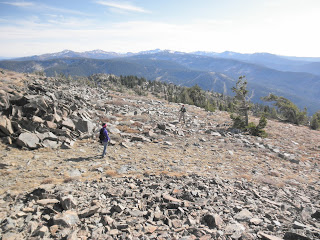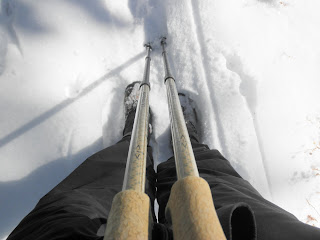 See the tiny people on the top of Ralston Peak above?
See the tiny people on the top of Ralston Peak above? That's my group, and that's where I had lunch. :) We didn't climb up the sheer rock wall; instead, we hiked up the ridge, which was exciting enough, thankyouverymuch.
Weather: beautiful; sunny, chilly, but amazingly great for November in the Sierras. Probably around 50s for start; once you get hiking, for the first half, you're in the forest, and consequently sheltered, so t-shirts and light pants are fine. In the second half of the hike, when you're on the exposed part of the hill, you're grateful for windproof pants/jacket/hat/gloves. It felt about 45 at that point, albeit a sunny cool and windy day on the peak.
Company: On this hike, I was grateful for company--my intrepid friend, Maria, came with me---and so she and I travelled solo up 50 to the Ralston Peak trailhead wherein we met up with the hiking group. There were maybe about 15 or so people on this hike, and as usual, we started out in a big long line of hikers but gradually, each found our place and speed and settled into the hike.
Stats re hike: Ralston Peak trailhead--directly opposite the 50 exit to Camp Sacramento. A little tricky to get to because it's right on a corner, but plenty of parking, so no problem there. Hike was about 7.5 miles or so. We hiked the longer, not so steep way, in order to see the Lake Aloha overlook, but if you go the more direct route up to the peak, it's about .5 mile shorter (but much steeper). We hiked for about 2.5 hours up and then maybe 2 hours down? We didn't keep tight watch of the time for this hike.
Out and Back hike: Elevation gain: 2,735ft (from 6,500 - 9,235ft)
Below: the hike starts out in a series of switchbacks, ascending through the lower forest:
 Below:
Below: Periodically, you pop out into a clearing with magnificent view of the surrounding areas, including the unfortunately snow-free slopes of Sierra at Tahoe (which you can see in the pic below):
 Below
Below: after a mile or so, you enter the Desolation Wilderness area. We were with a group who already had permits, but there were no permits that I saw available (or even a place to sign up for them) at the trailhead. I'm not sure where you're supposed to get them from unless you want to go to Echo Lakes or another trailhead.

Below: The trail varied in terrain, but in the lower parts of the hike, the trail was hard packed dirt (easy to hike on):


Trail Notes: Once you get to the bottom of the peak, you can choose between two routes to the peak; a use trail, marked by cairns (piles of rock) that leads straight and steeply up the peak. That's about half a mile shorter than the other trail option, which leads off to the left.
The left trail, really the continuation of the main trail, is less steep but also about a half mile longer than the steep use trail. The long trail, however, also contains this stunning view of the Lake Aloha area, which was fun to see since I did that hike not too long ago.
Below: About three miles into the hike, once you're through the forest and out onto the slopes of Ralston Peak, you come across the overlook to Lake Aloha and Lake of the Woods and some amazing Desolation Wilderness scenery.


In the pics above, you can see Pyramid Peak (off on the left), followed by Dicks Peak, and then, I don't think you can see it really, off on the far right, is Mount Tallus--a goal of mine for spring 10.
Below: A piece of wood demonstrating exactly the harsh effects of a life at over 9000 feet:

Almost directly opposite the Lake Aloha overlook is the use trail (ie unofficial trail), marked by cairns (or clearly people-made balanced piles of rocks) indicating the way up to the peak. Keep an eye out for the cairns, which are placed strategically along the way; they can help you keep going toward the peak.
Below: On the way up to the peak; you can see that we have to hike/clambor over several hundred feet of loose tallus, precariously balanced pieces of granite, sheered off rock faces over the years. It was tricky but worth the hike to get to the peak.

The view from the peak was stunning; you could see 360 degrees from Echo Lake to Lake Aloha (past Mt Tallus), all the way round to Sierra at Tahoe with whole number of peaks with which I'm unfamiliar. Stunning views and a great place to have lunch.
Below: I think this is a pic of Lake Aloha from Ralston Peak :

Below: Echo Lakes (upper and lower) from Ralston Peak:

Below: After lunch, a small group, including Maria and I, hiked off to the east to find some little lakes called "Cup Lake" and "Saucer Lake." First, though, we had to survive this tallus field:

 Below:
Below: We missed Saucer Lake because we'd moved off the tallus field onto the more hiker-friendly meadowland, but we did see Cup Lake--an amazing little patch of water completely hidden from view inside a very steep 'cup' of granite. Worth the additional little hike to see it.
 Gear Notes:
Gear Notes: I definitely needed windblocker gear for this hike; while it was calm and warmish in the lower forest hike, once out onto the slopes of the peak, the weather, while still sunny, was quite a bit cooler and windier; windblocker pants (REI Mistral) and softshell jacket (REI Mistral again) both proved their worth today as did a windblocker hat and gloves. I was very glad I had bought/worn them along.
Below: Finally, the forest on the way back down again; a beautiful hike, with great company, on an amazing weather day for November up at the hill.
 Below:
Below: Ralston Peak from Google Earth: you can see Cup Lake at the bottom right, Echo Lakes at the top right/middle and possibly Triangle Lake above the Echo Lakes.

Learn more about Ralston Peak: http://www.trailspotting.com/2007/12/mt-ralston-peak.html



















































